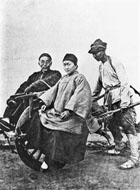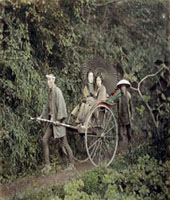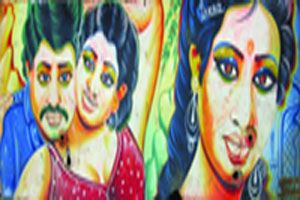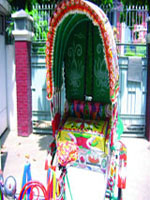List of Bangladeshi Blogs- from The 3rd World View
on Bangladesh affairs and general issues
The 3rd World View One of the pioneers in Bangladesh blogging and most vibrant. The blogger, Rezwan, stays in Germany with his heart in Bangladesh
Or How I learned to Stop Worrying-discourse on Bangladesh and beyond of Mashuqur Rahman who lives in Washington
bangladeshblogger- a technically advanced bangladeshi blog
on politics and current affairs
Megh Barta-An online forum for activism edited by Anu Ahmed
Unheard voices-Voice of expatriates -Dristipath group-about all things Bangladesh
Shada Kalo-a running commentary on bangladesh politics
Info.com.bd- a blog of RTV
In the middle of nowhere- expressions of an angry young man from Bangladesh who is now residing in USA and who could see beneath the surface of an issue
Dristipat writers collective - the young intellectuals blog
Xanthis is made in Bangladesh
Isa Khan’s Blog- keen on cross border relations
Politicobd.com-on corruption in Bangladesh politics
On economy
Bangladesh Economic News
Hobby Economist-On global business & economy
Bangladesh Textile Residency-Ismini Samanidou and Gary Allson on their residency on Textile in Bangladesh
Bangladesh Development Research Centre
On corporate culture
Bangladesh corporate blog- analysis and information on corporate business in Bangladesh
on personal accounts
Here I am – m@q’s journey through life
Random musings..or..fashionable self-righteousness- Fariha is an occassional blogger
Life in Eskaton – sketch of life by Shoaib Alam
Born from the ashes of blood- a different look at life by Shohana
AISajib-a young and enthusiastic blogger
Think & Grow rich- Shimul with high hopes and emotions
Fug’s blog – from UK
Bangladesh 2020 – bangladeshiheart with an eye to 2020
Life as I Know It-Intiza’s blog on improving the world and improving the innerself
Noman47′s weblog-who feels pain for Bangladesh
Kapalikana- blog of kapalik who loves to travel in jungle
Lipna’s world-a bangladeshi girl’s dream based in New York
Imperfect world-Shafiur stays in Uk, travels the world and discusses the events of the world as he sees it.
Niaz blog- Personal diary of Niaz at present based in Dublin
Xitu’s blog- an interesting personal blog from Xitu of Bangladesh
Lights & Shadows -thoughts and feelings of a life
on Yunus- the Nobel laureate
yunusphere.net-Though not of Bangladesh origin, Sabine and Lilly from UK are expanding Dr. Yunus sphere of influences by promoting Social Business and Grameen principle of ‘Credit without Collateral’
studyunus.net- a discussion into the studies of ‘Creating a world without poverty’ and social business
on ICT & telecommunication:
ZSapan;s blog -On tecnology and personal accounts
Brook Song- a blog on ICT, not on poetry
JIPL Blog- conversation with JOBS-ICT private Limited
IT 4 Hope -Information technology with positive social impact-From Sabine with an eye to Bangladesh
Netty Gritty- Sanjida’s blog on blogging tips, wordpress ticks, web tool, web resources etc
SathRong-for web design and graphic design
Nafiainfosys-an offshore software development house
Sandhi’s writing – is a collection of Muhammad Arefin Sandhi’s articles on technology, nature, environment and science in leading newspapers of Bangladesh
TechnologyUpdate- a blog with with updated information on technology
on Climate Change:
Hungrytide-blogging on climate climate change from Bangladesh
Is anybody listening? – a dristipath blod on climate change and its impact on south east asia
on financial management
golam morshed – financial management consultant for third sector, based in UK
on academic/research support:
ReportBD.com- a blog for reports,assignments, case studies and term papers
Bangladesh Debating Council
-for improving the culture of debate in Bangladesh
Group Blogs/Blog directory/Social blogging:
E-Bangladesh – based in London a news/headlines service and a group blog aimed at bringing the news and analysis from Bangladesh to its readers
BD Bloggerz-m@q’a great attempt to float a directory for all bangladeshi bloggers
somewhere in.. -Pioneer Bangla platform
Sachalyatan A Popular Bagla social blogging
Alochana Online -a daily participatory discussion on the events of Bangladesh
on energy:
Energy Frontier – news and views on energy sector of Bangladesh
Energy Bangla Exploration of porspect, progress and problem of energy sector in Bangladesh
on agriculture, health & nutrition:
The vegetable blog – an unrelated chronicles of a country called Bangladesh
on Photography::
ShahidulNews- Musings by Shahidul Alam
Geoffrey Hillar-Photgraphs and notes from Bangladesh of a Fullbright scholar
Salman Saeed Bangladeshi Photographer
monirulDiarywitness my eyes
on Fashion::
Aneeta’s style notes-on fashion trend in Bangladesh
on Art:
Fahana’s blog Farhana is a fine miniature artist based in USA
Samad’s artwork- A blog by TE Samad on artwork and dogotal composition. Samad stays in UK
Life in Toons- a look into the cartoons by Asif
Cartoon Studio- A cartoonist look at life and events by Arifur Rahman
on Tour and Travel:
bdholidays- a bangladesh portal for tourism
Meandering Memos- a traveler’s account – some are on Bangladesh
on Community Development:
Voice of the South- an online platform for south asian community development
Transparency for Development-for bringing transparency in business to rural Bangladesh
on NRBs
ScholarsBangladesh.com
Linkedbd- an website for professionals of home and abroad
EB2000 Expatriates Bangladesh 2000
On Poverty
Uncultured.com -An wonderful project to alleviate poverty by Shawn
On space & astronomy
Space & Universe: An intense discourse on space by Emran Khan of AIUB,Dhaka.
 Porabari is a village. It is situated about four kilometers west from Tangail town. Its sight is calm and quiet. The village was named Porabari because the house of a sweet maker businessman was burnt (Porabari means “burnt house”). Nobody can ascertain the name of the man who first made this sweet meat. It is known that a man named Dasarat was the first sweetmeat maker in this village. The Ghosh and Pal tribes were engaged in the sweet meat industry generation after generation.
Porabari is a village. It is situated about four kilometers west from Tangail town. Its sight is calm and quiet. The village was named Porabari because the house of a sweet maker businessman was burnt (Porabari means “burnt house”). Nobody can ascertain the name of the man who first made this sweet meat. It is known that a man named Dasarat was the first sweetmeat maker in this village. The Ghosh and Pal tribes were engaged in the sweet meat industry generation after generation. From the old sweet makers and sweet traders it is known that once there was a launch ghat at Porabari. The bank of Dhaleshari is a branch river of the Jamuna. Steamers, launches and big cargoes anchored there. Men of different position and taste used to come to Porabari. Once, Porabari was a thriving business centre where men including luxurious living gathered all the time. The fame of the Porabari chom chom sweet is not a matter of recent years. It has been reigning for more than one and half centuries. The Porabari Chom Chom sweet was full of taste and juice as like as the honey of the bee hives. It is said that a man (Dasarat by name) or an unknown Thagore coming from Asam first started to make chom chom with the sweet water of Daleshary mixed with the thick milk of Porabari. It can be cited that the taste of chom chom is mainly dependent on the taste of the water of Porabari. The secrecy that lies behind the preparation of chom chom of Porabari is the water of Porabari.
From the old sweet makers and sweet traders it is known that once there was a launch ghat at Porabari. The bank of Dhaleshari is a branch river of the Jamuna. Steamers, launches and big cargoes anchored there. Men of different position and taste used to come to Porabari. Once, Porabari was a thriving business centre where men including luxurious living gathered all the time. The fame of the Porabari chom chom sweet is not a matter of recent years. It has been reigning for more than one and half centuries. The Porabari Chom Chom sweet was full of taste and juice as like as the honey of the bee hives. It is said that a man (Dasarat by name) or an unknown Thagore coming from Asam first started to make chom chom with the sweet water of Daleshary mixed with the thick milk of Porabari. It can be cited that the taste of chom chom is mainly dependent on the taste of the water of Porabari. The secrecy that lies behind the preparation of chom chom of Porabari is the water of Porabari.
















